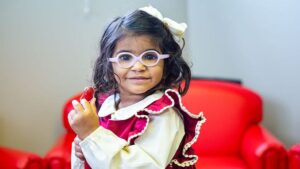“Deaf. Blind. Limitless.” This is the mantra of the Alabama Institute for the Deaf and Blind (AIDB) in Talladega, Alabama.
AIDB serves some 26,254 infants, toddlers, children and seniors at five campuses and eight regional centers across the state of Alabama. Five schools are housed within AIDB in Talladega – Alabama Institute for the Deaf, Alabama Institute for the Blind, Helen Keller School, E.H. Gentry and the Alabama Industries for the Blind, and there are programs such as the AIDB Regional Center and the Outreach to public schools statewide.
While the schools here are for students who are deaf and/or blind, they are schools academically just like any other and follow the Alabama Course of Study. Some students may have additional disabilities, but it doesn’t stop them. Some believe it may even empower them to do even more, thus the idea of “limitless possibilities.”
A walk through this lovely campus makes you feel like you are on any other school campus, though you may see kids talking with sign language or using a cane. Some students may have varying levels or vision or hearing loss, and some have multiple disabilities.
With a 98 percent graduation rate, the educators and students must be doing something right. The AIDB serves toddlers through 12th grade, as well as vocational education for adults and senior citizens.
In addition to educational services, the school offers great extracurricular activities for students such as sports, music and agri-science. AIDB is also known around the state as a sports powerhouse, particularly in wrestling, competing against regular public schools statewide.
Alabama School for the Deaf offers both traditional and non-traditional education for students ages 3-21. Housed on the institute campus, the school is somewhat different as it offers a 24/7 residential and educational experience.
Students have opportunities to participate in several enriching extracurricular activities that include clubs, organizations, math team academic bowl, Junior National Association of the Deaf membership, sports, field trips and more.
There is no charge for room or board for this program designed for students from Alabama.
Coming in APRIL: more information on AIDB and its Horse Therapy Program – where the miracle continues.
The Alabama School for the Blind, led by President Dr. John Mascia since 2012, is a fully-accredited residential and day school. Just like any other school, it strives to create well-rounded students not just academically, but socially, artistically and in sports. In fact, ASB athletes compete at a high level against state public schools, even traveling to other states to compete with other schools for the blind. Most of all, the school strives to create students who can live independently.
Every ASB teacher has a state certification in his subject area plus a visually impaired certification at a master’s level. All teachers also receive the Library of Congress Braille Transcription certification.
As the teachers here say, math and science can be particularly difficult to teach to students with vision loss, but they are amazingly creative about finding alternative methods to teach these subjects. Students in this school use all types of technology such as laptops, iPads, the Voice Notes app and Braille. The ASB’s graduation exam is considered one of the most rigorous high school exit exams in America.
The Helen Keller School offers functional-based instruction to sensory-impaired students who have multiple disabilities. Using methods like caring for farm animals, the school has an individual approach to living and work skill development.
Because their students have multiple sensory impairments and may need help with mobility, classes tend to be smaller here and are even more specialized for these students. For many of them, the main educational goal is daily living skills such as dressing, feeding themselves, grooming and other skills. Traditional academics are also taught.
The institute also serves as a statewide resource and library. The first-floor library here can print any textbook in Braille. In fact, it is a clearing house for Braille textbooks throughout the state. It is also part of a STEM partnership across nine states within the Southeast.
In 1968, AIDB partnered with the Alabama Department of Rehabilitations Services to create the E.H. Gentry Technical Facility, an independent living and job training programs for adults who are deaf, blind or both. Interestingly, former Alabama Gov. James “Big Jim” Folsom was among the students there when he lost his eyesight. The program is considered one of the top such programs in the country.
The main focus of E.H. Gentry is vocational and educational rehabilitation, providing quality job skills and education so that its students can become employed and independent.
The AIDB is the state’s largest employer of adults who are blind, deaf or deaf/blind. AIDB operates supply stores on military bases at Redstone Arsenal and Fort Rucker, as well as bases in Georgia. Manufacturing is a vital part of the industries program at AIDB, and blind employees make flight bags, biodegradable deck mops for the U.S. Navy, note pads, brushes and safety vests for the Alabama Highway Department, screen printing and biscuit mix bags for Jim ‘N Nick’s Bar-B-Q, and embroidered hats for Honda Manufacturing of Alabama.
For more information about any of the AIDB schools or programs, visit www.aidb.org.
Carol Muse Evans is publisher of Birmingham Parent.





